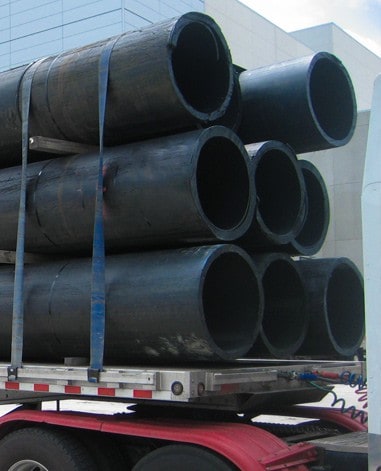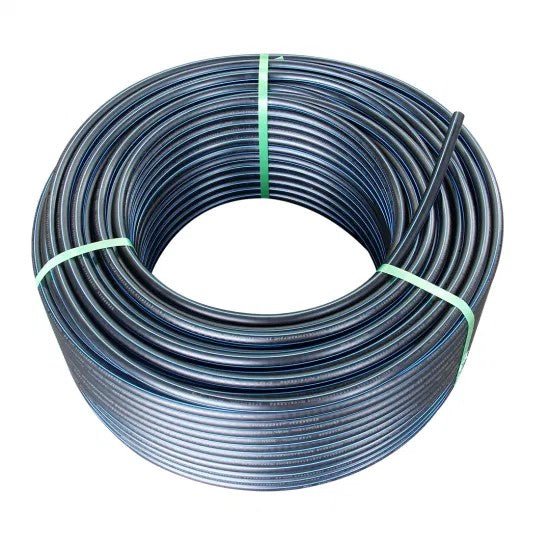American Plastics HDPE Pipe for Oilfield: Built for Harsh Conditions
Discover the Production Process Behind High-Quality HDPE Pipeline and Its Applications
The manufacturing procedure of top quality HDPE pipelines is intricate and systematic. It begins with the selection of resources that improve efficiency. Following this, ethylene goes through polymerization to create resin, which is after that formed with extrusion. Quality control is extremely important, ensuring that the final product fulfills strict standards. The journey of HDPE pipelines doesn't finish with manufacturing. Their applications across various sectors disclose a broader value worth checking out.
Comprehending HDPE: Features and Advantages

High-density polyethylene (HDPE) is a flexible thermoplastic known for its resilience and resistance to different environmental aspects. This material shows exceptional tensile strength, making it appropriate for demanding applications. Its low-density framework adds to a light-weight product, facilitating ease of dealing with and installation. HDPE likewise showcases impressive resistance to chemicals, which lessens degradation when revealed to rough compounds.
The material's low wetness absorption additionally boosts its long life, making it perfect for usage in pipes and tank. In addition, HDPE is immune to ultraviolet (UV) radiation, making certain that items maintain their honesty also when subjected to sunshine. Furthermore, its versatility permits the creation of intricate forms without compromising toughness. The environmentally friendly nature of HDPE, typically stemmed from recycled materials, contributes to its appeal, promoting lasting methods in production. Overall, these homes and benefits make HDPE a favored selection for numerous commercial and customer applications.
Basic Material Option for HDPE Production
The choice of raw products for HDPE production is vital to verify the end product satisfies the preferred specifications and high quality criteria. High-density polyethylene (HDPE) is mainly created from polymerized ethylene, stemmed from fossil fuels such as natural gas or petroleum. The top quality of these feedstocks significantly affects the mechanical and thermal residential or commercial properties of the final HDPE.
Ingredients additionally play a significant function in enhancing HDPE's efficiency, including anti-oxidants, UV stabilizers, and colorants, which enhance toughness and resistance to environmental aspects. The option procedure need to consider not just the chemical make-up of the raw products however also their processing attributes to assure effective manufacturing.
The sourcing of raw products should prioritize sustainability and compliance with ecological regulations, as liable practices are crucial in today's market. Inevitably, mindful basic material option lays the structure for generating high-quality HDPE pipes suitable for varied applications.
The Extrusion Refine: Shaping HDPE Pipe
The extrusion process plays an essential function in shaping HDPE pipes, beginning with careful material preparation methods that assure perfect flow and consistency. Similarly crucial is the style of the die, which straight influences the final measurements and surface high quality of the pipe. With each other, these factors add substantially to the effectiveness and top quality of HDPE pipe production.
Product Preparation Methods
Effective production of HDPE pipelines starts with precise product preparation techniques, specifically the extrusion procedure. Throughout this stage, high-density polyethylene resin is very first dried to eliminate wetness, ensuring optimal flow qualities. The resin is then fed into the extruder, where it undertakes home heating and melting, transforming into a thick state. This home heating process is meticulously managed to maintain the material's integrity and performance. The molten HDPE is forced through a die, forming it into a continual pipe type. Proper temperature level monitoring during extrusion is essential, as it straight affects the product's residential properties and the last product quality. Once shaped, the HDPE pipe is cooled and reduced to specified sizes, prepared for succeeding processing and applications.
Die Design Importance
Accuracy in die style plays an essential function in the extrusion process of HDPE pipes. The die functions as the final shaping tool, straight influencing the pipeline's dimensions, wall surface thickness, and surface area coating. A properly designed die warranties uniform product flow, minimizing defects such as irregularities and weak points. The geometry of the die must be enhanced to fit the particular buildings of HDPE, including its viscosity and thermal habits during extrusion. In addition, the cooling rate of the material as it goes through the die can noticeably impact the pipeline's architectural integrity. Spending in advanced die modern technology is vital for producers aiming to generate high-quality HDPE pipes that satisfy industry requirements and customer assumptions.
Quality Assurance Procedures in HDPE Production
Although different aspects influence the top quality of HDPE pipeline production, reliable quality assurance actions are vital to assure uniformity and dependability in the last product. Key quality assurance methods consist of strenuous material examination, confirming that the raw polyethylene fulfills well-known criteria for purity and thickness. Throughout the extrusion process, parameters such as temperature, pressure, and cooling time are very closely checked to keep dimensional precision and structural honesty
In addition, post-production screening is important; suppliers usually carry out hydrostatic examinations to evaluate the pipe's strength and resistance to pressure. Aesthetic evaluations for surface area flaws further boost quality control. Qualification from pertinent requirements companies, like ASTM or ISO, supplies an added layer of reputation. By carrying out these extensive top quality control steps, suppliers can minimize issues, improve performance, and make certain that the HDPE pipes satisfy the specific demands of numerous applications, ultimately resulting in customer contentment and rely on the item.
Applications of HDPE Pipeline Across Industries
HDPE pipelines are utilized across numerous fields as a result of their durability and adaptability. In water circulation systems, they ensure efficient delivery, while in wastewater administration, they supply trusted services for waste transport. Furthermore, agricultural irrigation networks gain from HDPE's resistance to rust and versatility, making it an find excellent choice for modern farming methods.

Water Distribution Systems
A significant variety of industries count on high-density polyethylene (HDPE) pipes for reliable water circulation systems. Known for their durability and resistance to rust, HDPE pipes are extensively made use of in community supply of water networks, farming watering, and industrial applications. Their lightweight nature assists in simple handling and installment, decreasing labor costs and time. Additionally, HDPE pipes can suit various pressure degrees, making them suitable for both reduced and high-pressure systems. hdpe pipe in stock Midland TX. The adaptability of the material permits seamless integration into existing facilities, decreasing the demand for substantial excavation. Additionally, HDPE's resistance to chemical seeping warranties that the water supplied continues to be safe and clean, making it a suitable choice for maintaining the quality of potable water across numerous fields
Wastewater Monitoring Solutions
Reliable water distribution systems additionally lead the way for cutting-edge wastewater administration options, where high-density polyethylene (HDPE) pipelines play a considerable role. Prominent for their longevity and resistance to corrosion, HDPE pipes are suitable for carrying wastewater in numerous settings. Their adaptability enables simple installment in complicated settings, reducing the need for extensive excavation. In addition, HDPE's smooth interior surface lowers rubbing, enhancing circulation rates and effectiveness. These pipelines are also immune to chemical leaching, making certain that contaminants do not jeopardize the surrounding setting. Industries, communities, and treatment centers increasingly rely upon HDPE pipelines for their reliability and durability, making them a preferred option for modern-day wastewater monitoring systems. This adaptability highlights the vital importance of HDPE pipelines throughout countless applications.
Agricultural Irrigation Networks
Agricultural irrigation networks profit considerably from using high-density polyethylene (HDPE) pipes, which provide effective and trusted water delivery to crops. HDPE pipes are lightweight, making them simple to move and set up, while their flexibility permits different configurations in varied surfaces. These pipes demonstrate exceptional resistance to rust, chemicals, and UV radiation, guaranteeing resilience in rough farming settings. In addition, their smooth indoor surface area reduces friction loss, enhancing water circulation and minimizing power expenses connected with pumping. The longevity of HDPE pipes, frequently exceeding 50 years, adds to reduce upkeep and replacement expenses. Consequently, farmers increasingly depend on HDPE pipes to boost irrigation effectiveness and promote sustainable from this source farming techniques, eventually resulting in improved plant yields and resource preservation.
Future Patterns in HDPE Pipeline Modern Technology
As the demand for sustainable and effective facilities expands, advancements in HDPE pipe innovation are positioned to change different markets. Arising fads consist of the integration of smart technologies, such as sensors and IoT capabilities, which assist in real-time surveillance of pipeline problems, lowering upkeep costs and stopping leakages. Furthermore, the advancement of advanced production strategies, such as 3D printing, is making it possible for the manufacturing of complicated, personalized pipe layouts that satisfy details job demands.
In addition, the concentrate on recycling and circular economy practices is driving the innovation of HDPE pipelines made from recycled products, boosting sustainability. Boosted jointing approaches, such as electro-fusion and mechanical fittings, are additionally boosting setup efficiency and reliability. The expanding focus on ecological laws is pressing makers to take on greener production procedures, making certain that HDPE pipes not just meet sector standards but additionally foster an even more lasting future for facilities development.
Often Asked Concerns
Just How Does HDPE Compare to Various Other Plastic Materials?
HDPE surpasses numerous various other plastic materials pertaining to sturdiness, chemical resistance, and versatility. Its low thickness and high tensile stamina make it perfect for different applications, frequently going beyond alternatives in both performance and long plastic pipe connectors life.
What Are the Ecological Influences of HDPE Production?
The ecological influences of HDPE manufacturing include greenhouse gas discharges, energy usage, and possible pollution from producing processes. In addition, incorrect disposal can lead to soil and water contamination, increasing worries concerning long-term ecological impacts.
Can HDPE Water Lines Be Reused?
Yes, HDPE pipes can be recycled. Many centers accept used HDPE for processing, transforming it right into brand-new items. This recycling adds to sustainability efforts, minimizing plastic waste while preserving resources and power in the production cycle.
What Is the Life-span of HDPE Pipes?

How Do Temperature Level Variants Influence HDPE Pipe Efficiency?
Temperature level variants considerably influence HDPE pipe performance, impacting flexibility and stamina. Heats can bring about softening, while reduced temperature levels may trigger brittleness, inevitably affecting the pipe's longevity and suitability for numerous applications in varied environments.